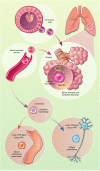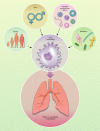Origin and ontogeny of lung macrophages: from mice to humans
- PMID: 31715003
- PMCID: PMC7218405
- DOI: 10.1111/imm.13154
Origin and ontogeny of lung macrophages: from mice to humans
Abstract
Macrophages are tissue-resident myeloid cells with essential roles in host defense, tissue repair, and organ homeostasis. The lung harbors a large number of macrophages that reside in alveoli. As a result of their strategic location, alveolar macrophages are critical sentinels of healthy lung function and barrier immunity. They phagocytose inhaled material and initiate protective immune responses to pathogens, while preventing excessive inflammatory responses and tissue damage. Apart from alveolar macrophages, other macrophage populations are found in the lung and recent single-cell RNA-sequencing studies indicate that lung macrophage heterogeneity is greater than previously appreciated. The cellular origin and development of mouse lung macrophages has been extensively studied, but little is known about the ontogeny of their human counterparts, despite the importance of macrophages for lung health. In this context, humanized mice (mice with a human immune system) can give new insights into the biology of human lung macrophages by allowing in vivo studies that are not possible in humans. In particular, we have created humanized mouse models that support the development of human lung macrophages in vivo. In this review, we will discuss the heterogeneity, development, and homeostasis of lung macrophages. Moreover, we will highlight the impact of age, the microbiota, and pathogen exposure on lung macrophage function. Altered macrophage function has been implicated in respiratory infections as well as in common allergic and inflammatory lung diseases. Therefore, understanding the functional heterogeneity and ontogeny of lung macrophages should help to develop future macrophage-based therapies for important lung diseases in humans.
Keywords: humanized mice; lung macrophages; ontogeny; origin; single-cell RNA-sequencing.
© 2019 John Wiley & Sons Ltd.
Figures



References
-
- Kopf M, Schneider C, Nobs SP. The development and function of lung‐resident macrophages and dendritic cells. Nat Immunol 2015; 16:36–44. - PubMed
-
- Hussell T, Bell TJ. Alveolar macrophages: plasticity in a tissue‐specific context. Nat Rev Immunol 2014; 14:81–93. - PubMed
-
- Joshi N, Walter JM, Misharin AV. Alveolar macrophages. Cell Immunol 2018; 330:86–90. - PubMed
-
- Garbi N, Lambrecht BN. Location, function, and ontogeny of pulmonary macrophages during the steady state. Pflugers Arch 2017; 469:561–72. - PubMed
-
- Liegeois M, Legrand C, Desmet CJ, Marichal T, Bureau F. The interstitial macrophage: a long‐neglected piece in the puzzle of lung immunity. Cell Immunol 2018; 330:91–6. - PubMed
Publication types
MeSH terms
Substances
LinkOut - more resources
Full Text Sources
Medical
Research Materials

